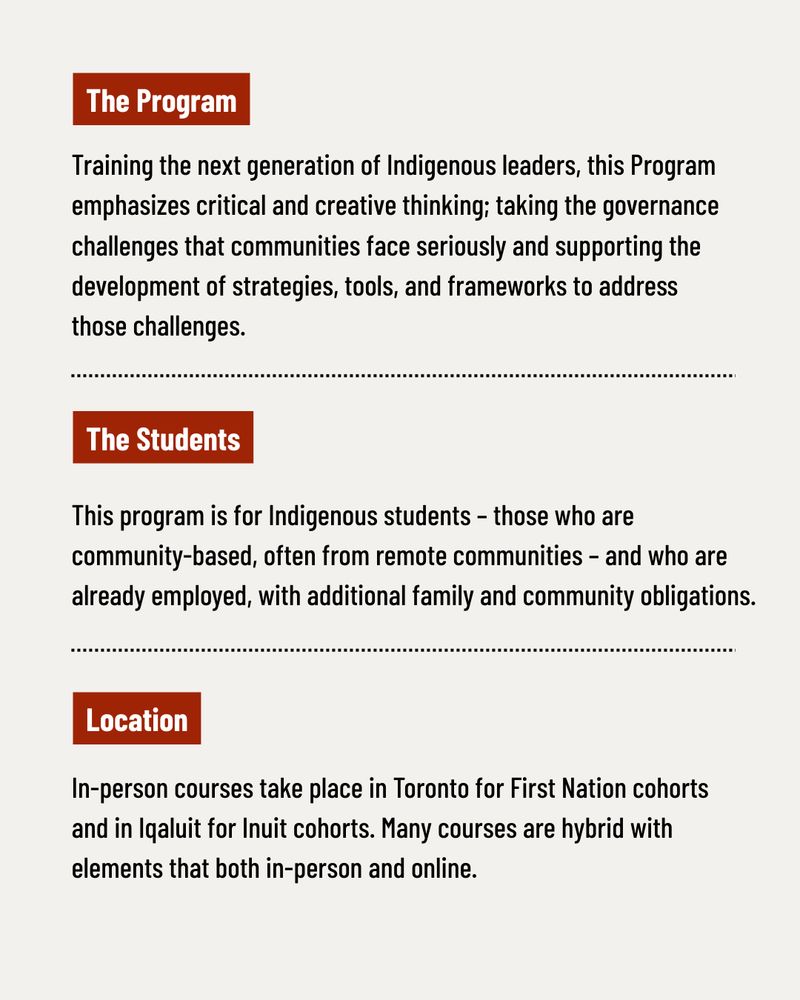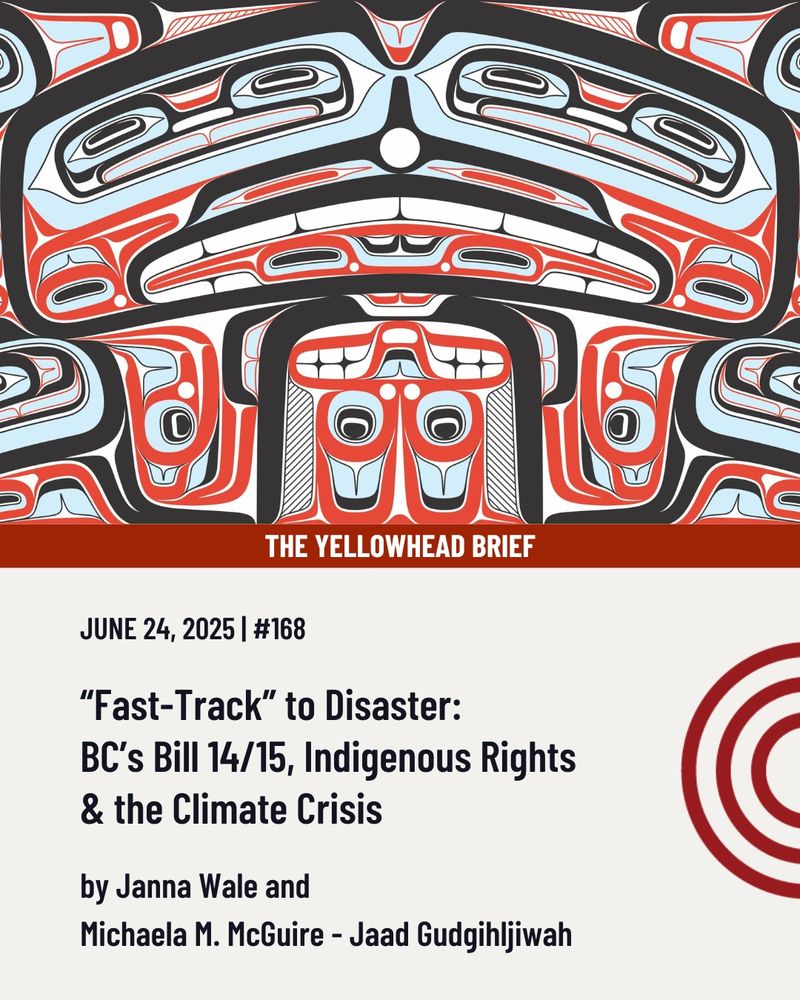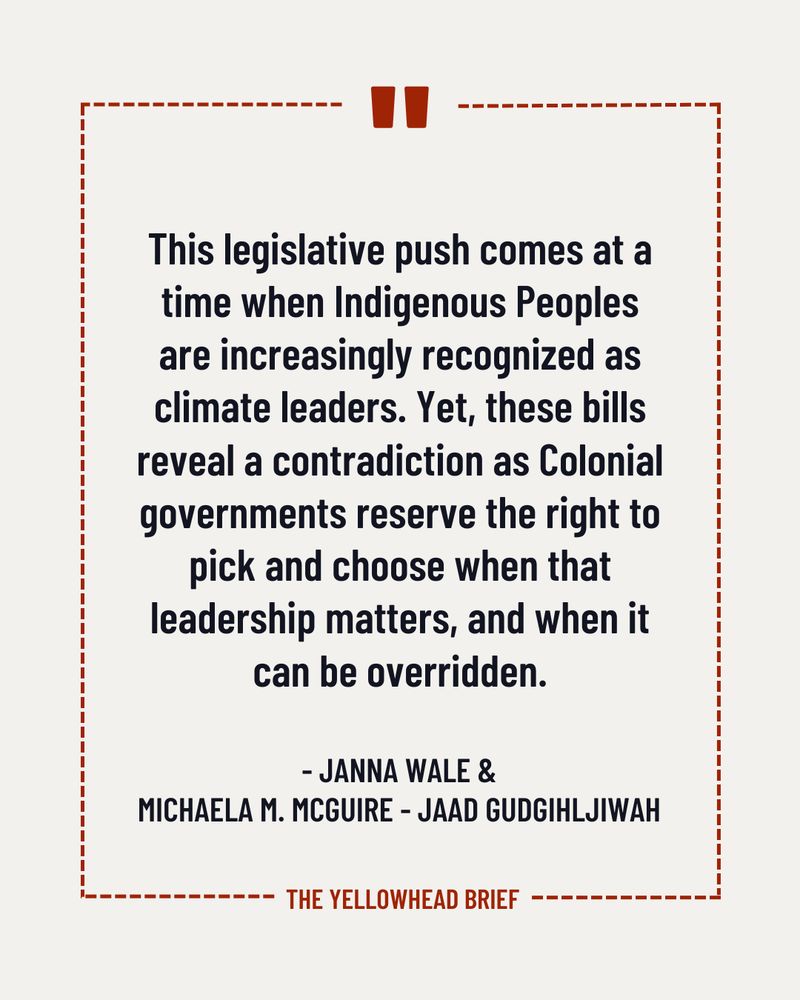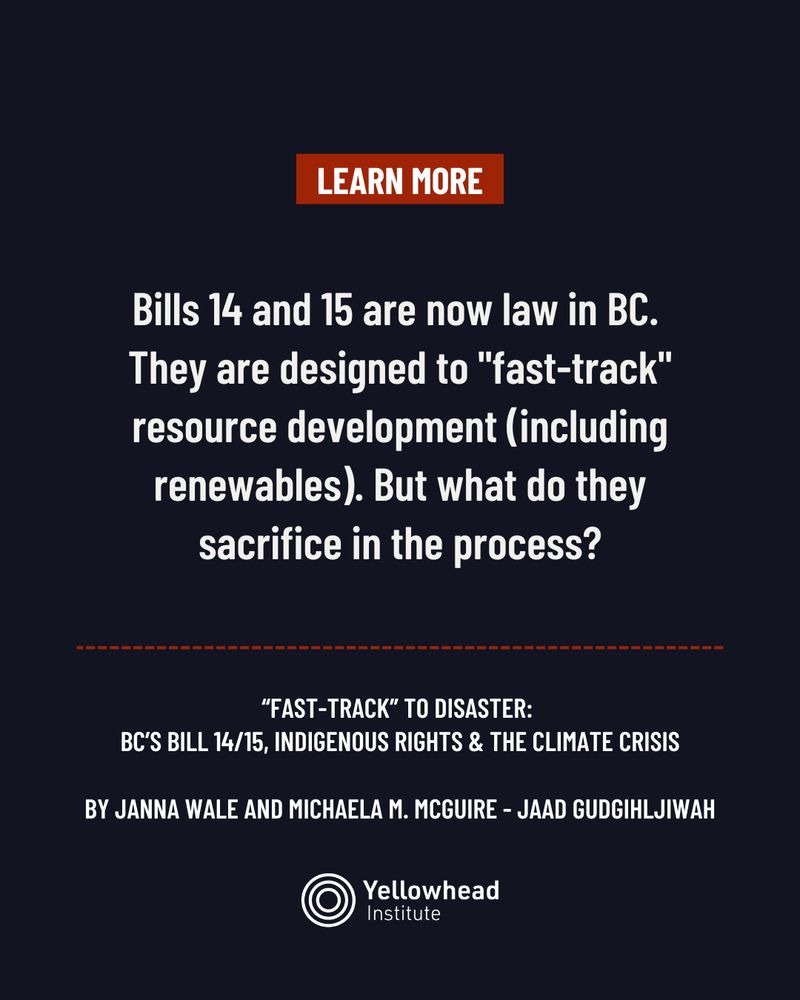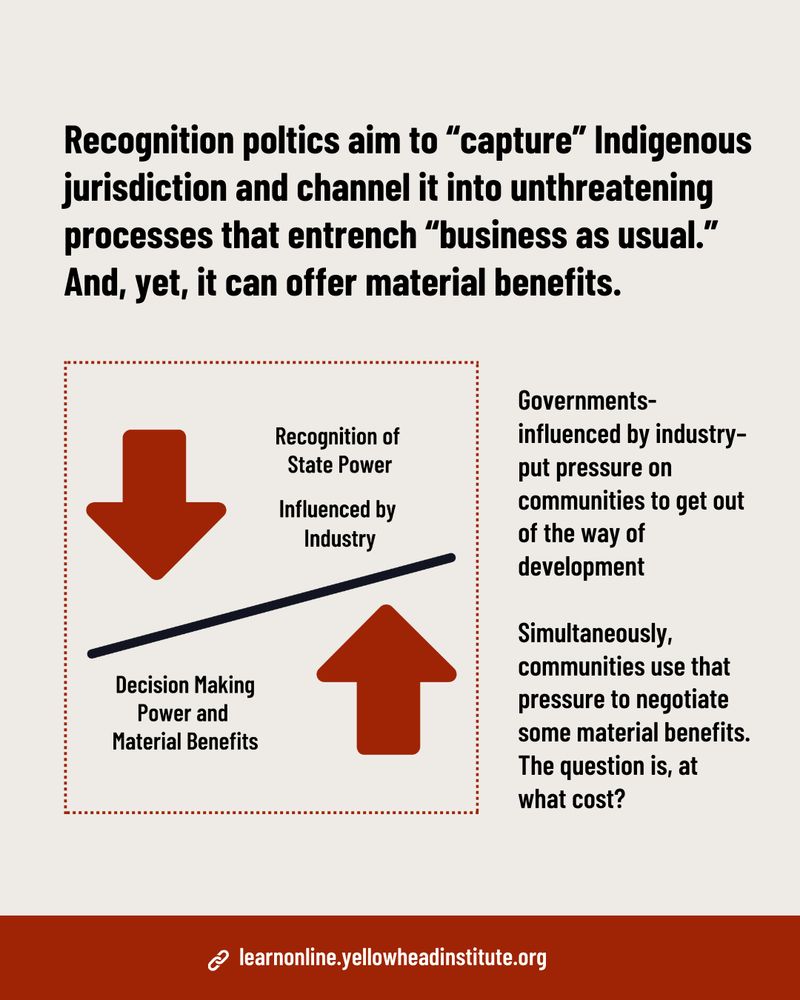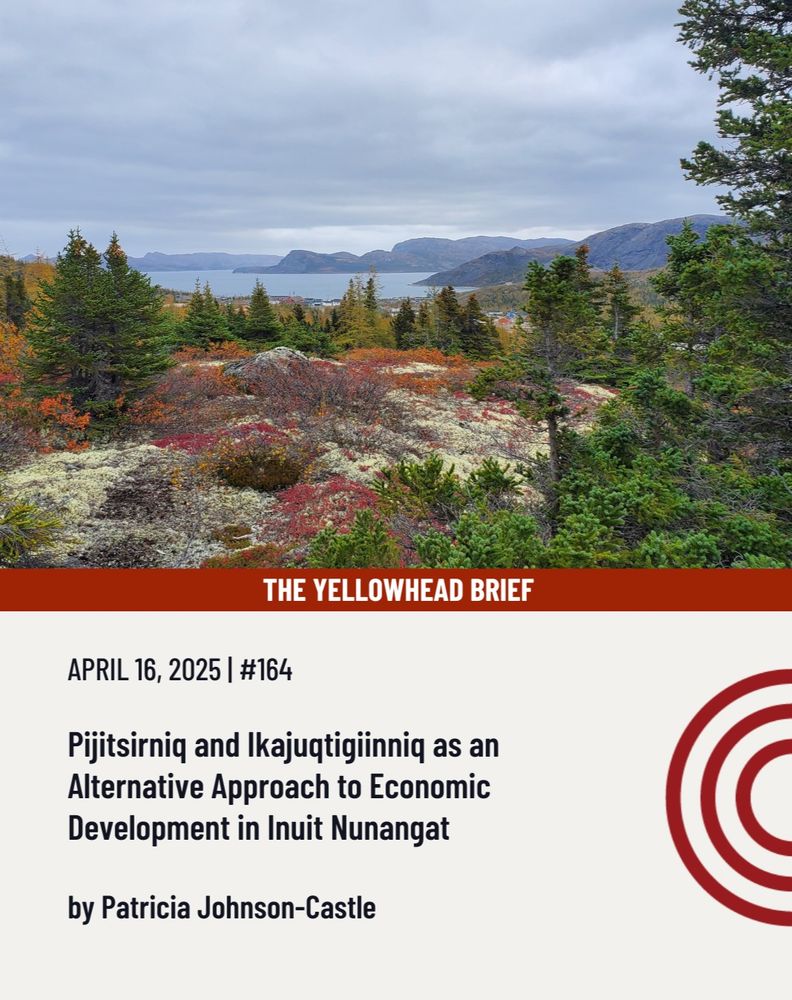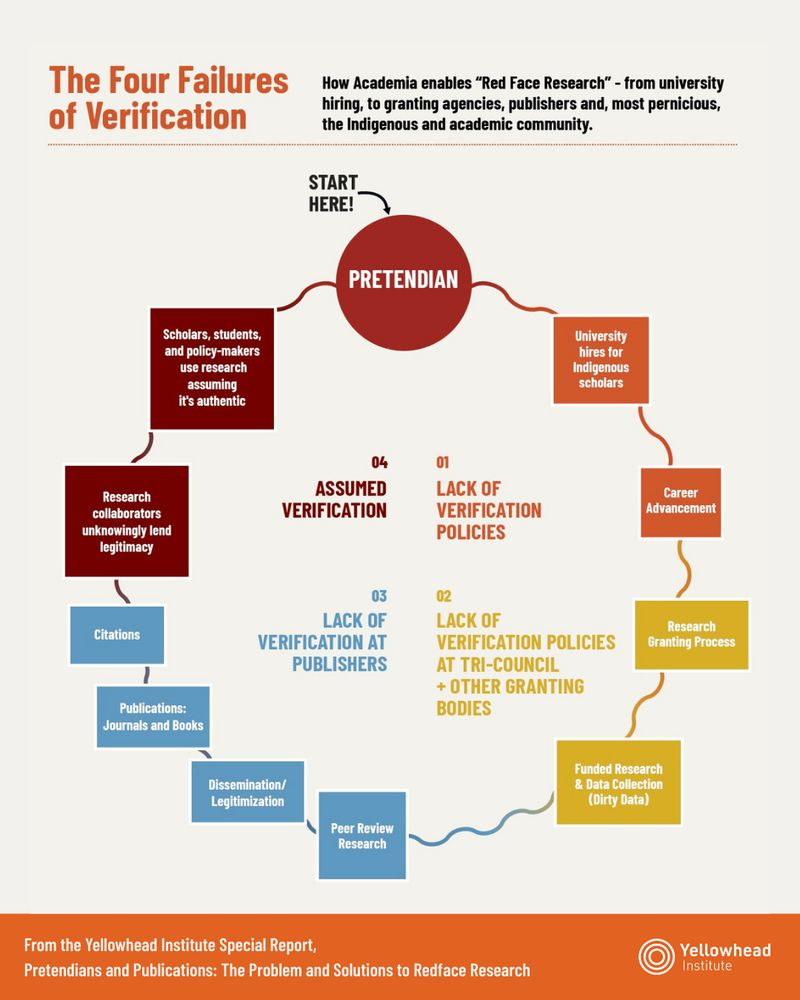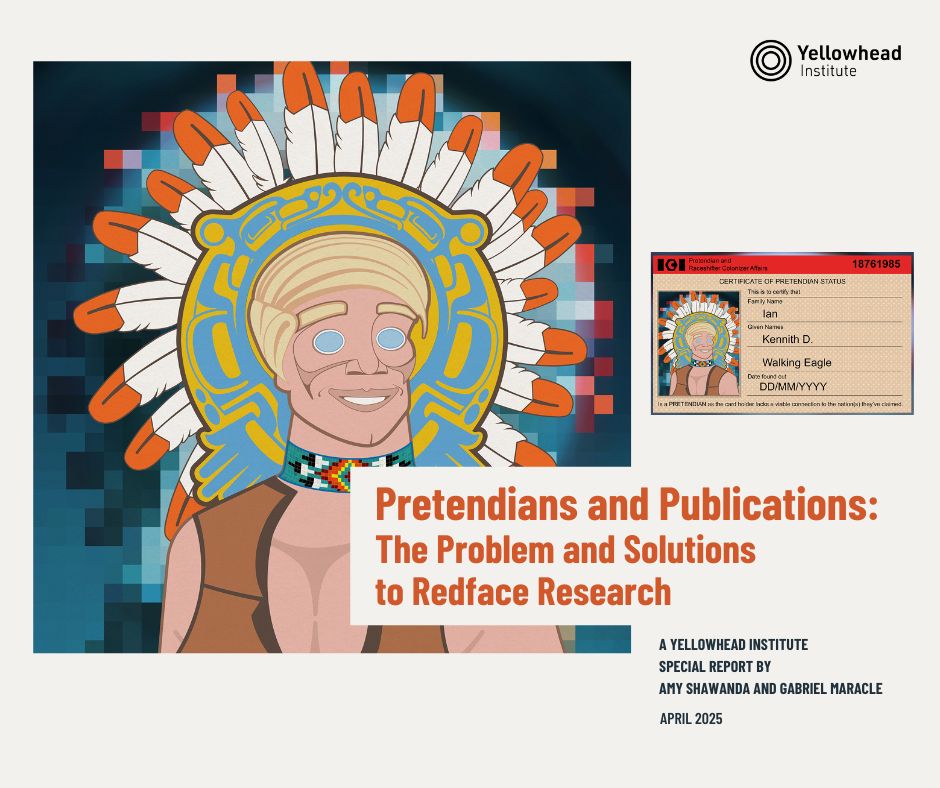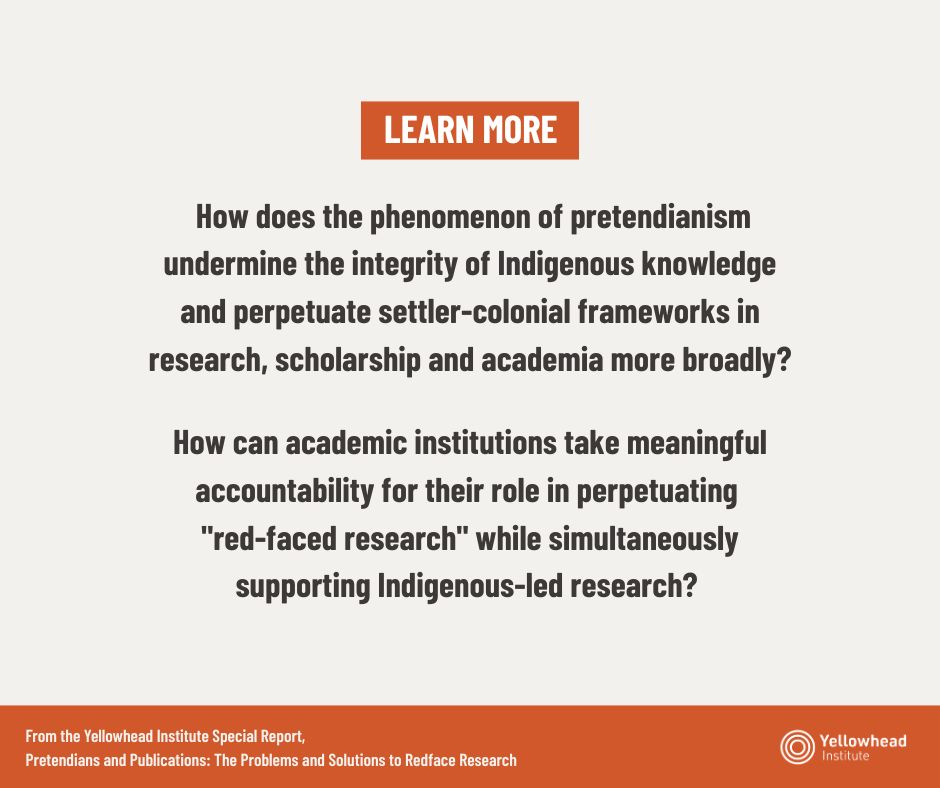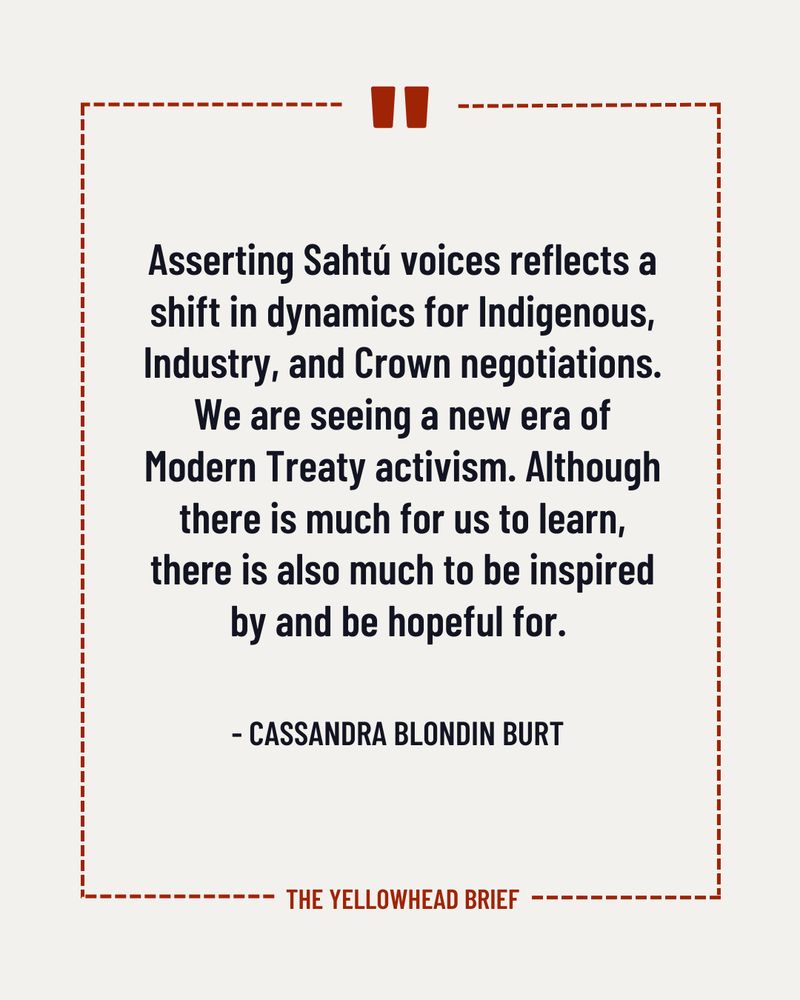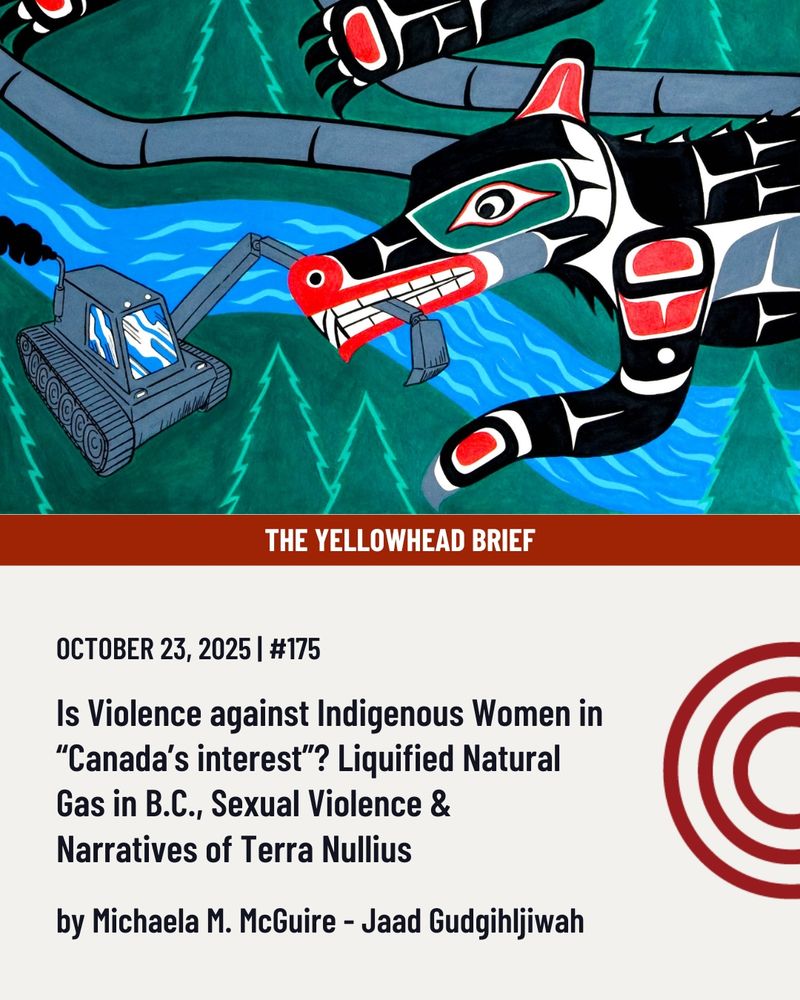
Top half of the image displays a photograph of No Pipelines by Gord Hill. A red line across the image beneath the photo. Within the line reads: “The Yellowhead Brief”. The bottom half of the image displays the brief title information: Is Violence against Indigenous Women in “Canada’s interest”? Liquified Natural Gas in B.C., Sexual Violence & Narratives of Terra Nullius by Michaela McGuire. The YI logo is displayed on the right side of the image.

a quote is bordered by a dashed red line. A quotation mark sits at the top centre of the border and “The Yellowhead Brief” is placed in the bottom centre of the border. Inside the border reads: We are dehumanized, our bodies and lives considered unworthy of care. We bear the brunt of environmental, colonial, and genocidal violence. This unfolds against the normalization of racism, which exacerbates societal indifference, perpetuating harm.

Image is of a dark blue background. A dark red text box is displayed in the top centre of the image, white text reads, “Learn More”. White text in the centre of the image reads:How do narratives of terra nullius intersect with resource development to perpetuate violence against Indigenous women?. Below this, smaller white text reads the title information:, Is Violence against Indigenous Women in “Canada’s interest”? Liquified Natural Gas in B.C., Sexual Violence & Narratives of Terra Nullius by Michaela M. McGuire - Jaad Gudgihljiwah A dotted red line separates the title information from the Yellowhead Institute logo displayed in the bottom centre of the image.
B.C.’s LNG boom is called progress—but for Indigenous women, it signals danger. Linked to man camps and state neglect, Michaela M. McGuire asks: what’s being done to protect women?
Read the full Brief, linked in bio.
23.10.2025 16:14 — 👍 8 🔁 7 💬 0 📌 1

Top half of the image displays a photograph of a boat on a body of water. A red line across the image beneath the photo. Within the line reads: “The Yellowhead Brief”. The bottom half of the image displays the brief title information:
Reflections on “Northern Squalor” and Sovereignty. The YI logo is displayed on the right side of the image.

a quote is bordered by a dashed red line. A quotation mark sits at the top centre of the border and “The Yellowhead Brief” is placed in the bottom centre of the border. Inside the border reads: I am not yet aware of any society’s well-being which is founded purely in the assertion of sovereignty, as though it were the honest result of good intentions. I thought the term for such a lie was colonialism?

Image is of a dark blue background. A dark red text box is displayed in the top centre of the image, white text reads, “Learn More”. White text in the centre of the image reads: Where is the discussion of Indigenous well-being in narratives that justify Canadian sovereignty in the North?. Below this, smaller white text reads the title information:, Reflections on “Northern Squalor” and Sovereignty by Dakota erutse. A dotted red line separates the title information from the Yellowhead Institute logo displayed in the bottom centre of the image.
In this Brief, Dakota Erutse traces the arc of these narratives and reflects on what Mark Carney's new unifying legislation obscures about Canada's relationship with the North.
Read the full Brief on our website, linked in bio.
16.10.2025 18:23 — 👍 2 🔁 1 💬 0 📌 0

Top half of the image displays a close-up photograph of a hand-stitched patterned quilt by Bailey Bornyk. Red beadwork of flowers is stitched on the left and right sides of the image. Blue and green beadwork is stitched into the middle of the quilt. Below the photograph is a red line across the image beneath the photo. Within the line, white text reads: “The Yellowhead Brief”. The bottom half of the image displays the brief title information on an off white background. On the left side, small black text reads: “October 07, 2025 | #173.” Larger black text below displays the brief title: “The “Cows and Plows” Treaty Settlement: Overview and Implications.” At the bottom of the image, smaller black text reads “by Gina Starblanket and Courtney Vance.” The Yellowhead Institute logo in red is displayed on the right side of the image.

Image is of an off white background. Black text in the centre of the image reads: “Settlements for agricultural benefits claims can reinforce an understanding of treaties as one-time transactions of material items rather than living agreements to be revisited and renewed. This gives the Crown’s account of treaties greater authority than Indigenous ones.” Below this, smaller black text reads: “- Gina Starblanket & Courtney Vance.” The text is bordered by a dashed red line. A quotation mark sits at the top centre of the border and “The Yellowhead Brief” is placed in the bottom centre of the border.

Image is of a dark blue background. A dark red text box is displayed in the top centre of the image. Within the box, white text reads, “Learn More”. White text in the centre of the image reads: “Do “Cows and Plows” settlements represent a genuine fulfillment of treaty promises—or do they prioritize Crown certainty over ongoing reciprocity and structural change in nation-to-nation relationships?” Below this, smaller white text reads the title information: “The “Cows and Plows” Treaty Settlement: Overview and Implications.” Below the title information, small white text reads: “By Gina Starblanket and Courtney Vance.” The Yellowhead Institute logo in white is displayed at the bottom centre of the image. A dotted red line separates the large white text from the title information text.
Canada frames “Cows and Plows” as one-time settlements meant to close the books on agricultural treaty promises. In this Brief, Gina Starblanket & Courtney Vance explore what happens when restitution is narrowed to cash and closure. Is this truly honoring treaty promises?
Full Brief linked in bio.
07.10.2025 16:09 — 👍 0 🔁 1 💬 0 📌 0

Report cover titled "Braiding Accountability: A Ten-Year Review of the TRC’s Healthcare Calls to Action" featuring colorful floral artwork and publication details.

A quote highlights that true reconciliation requires redistributing power and resources, not just symbolic gestures. Yellowhead Institute logo and flowers are at the bottom.

A text graphic asks questions about reconciliation in Canadian health authorities, referencing the Yellowhead Institute's report on accountability and Indigenous governance in health care.
In the latest Special Report, JoLee Sasakamoose & Miranda Field find little progress in Canada's healthcare systems on restoring Indigenous wellness systems, creating ethical spaces, or transforming service delivery – showing how institutions remain performative.
Full Report linked in bio.
01.10.2025 12:35 — 👍 2 🔁 4 💬 0 📌 0

The image shows a graffiti-covered wall in the background. Title text in white text on black highlight reads: "Yellowhead Resources to Prepare for National Day for Truth & Reconciliation." Subtitle reads: "How can we avoid symbolic performances of reconciliation and equip ourselves to work toward transformative change?" The Yellowhead logo is displayed. In the bottom right corner of the screen, three arrows are displayed that indicate to scroll.
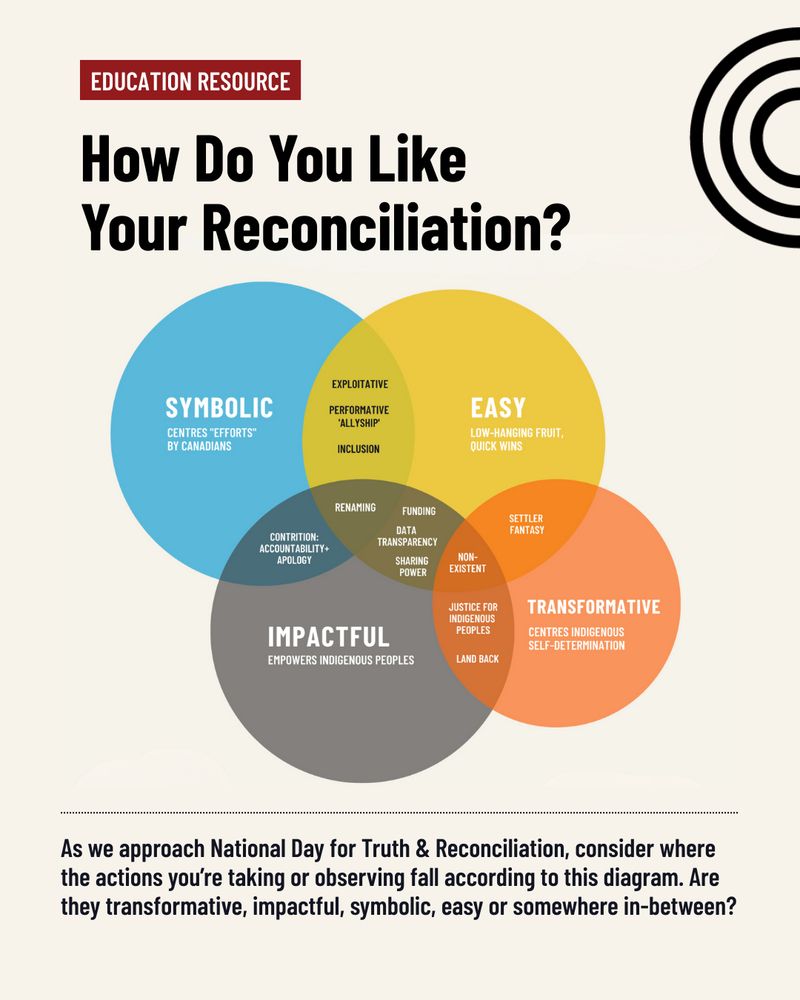
A red text box at the top reads: "Education Resources". Title text reads: "How Do You Like Your Reconciliation?" A venn diagram demonstrates 4 overlapping circles. The circles include 1. Symbolic: Centres "efforts" by Canadians. 2. Easy: Low-hanging fruit, quick wins. 3. Transformative: Centres Indigenous self-determination, 4. Impactful: Empowers Indigenous peoples.
Overlapping with Symbolic, easy, and impactful is: renaming
Overlapping with symbolic and impactful is: contrition: accountability + apology.
Overlapping with Easy, impactful: funding, data transparency, sharing power.
Overlapping with easy, impactful, and transformative: non-existent.
Overlapping with impactful and transformative: justice for Indigenous peoples, land back.
Overlapping with easy and transformative: Settler fantasy.
Overlapping with symbolic and easy is: exploitative, performative "allyship", and inclusion.
A dotted line separates the diagram and text that reads: "As we approach National Day for Truth & Reconciliation, consider where the actions you’re taking or observing fall according to this diagram. Are they transformative, impactful, symbolic, easy or somewhere in-between?"
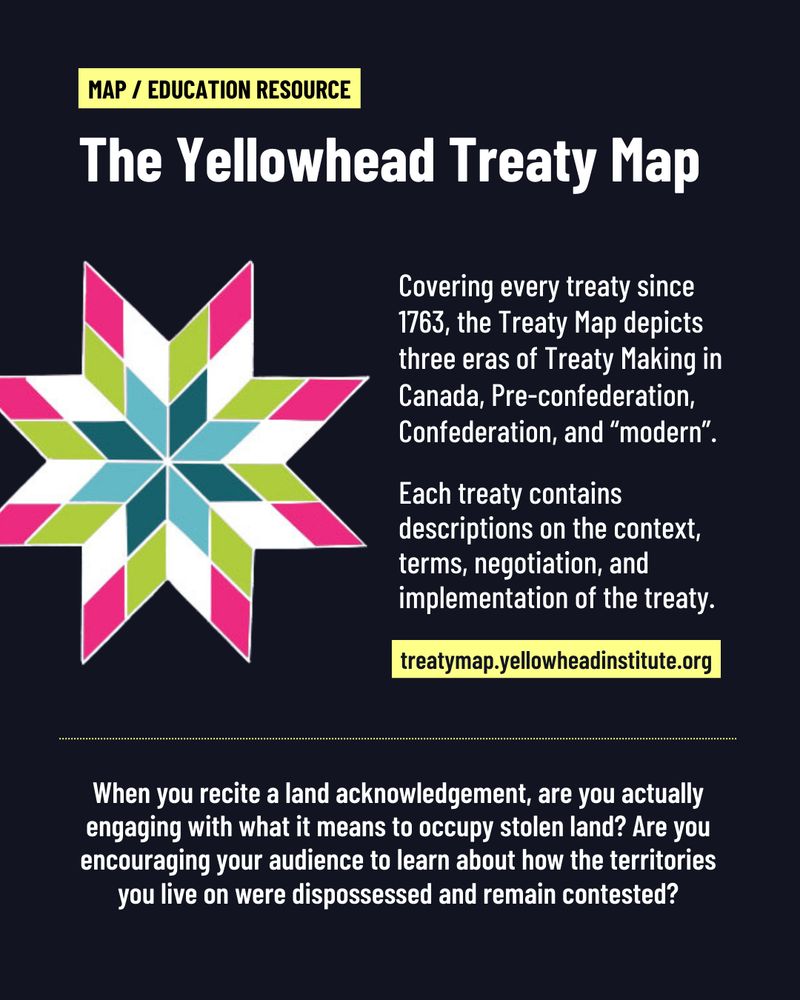
A yellow text box reads: "Map / Education Resource". Title text reads: "The Yellowhead Treaty Map" A star designed by Michelle Sound is displayed. Next to it, text reads: "Covering every treaty since 1763, the Treaty Map depicts three eras of Treaty Making in Canada, Pre-Confederation, Confederation, and "modern". Each treaty contains descriptions on the context, terms, negotiation, and implementation of the treaty." A yellow text box contains the URL: treatymap.yellowheadinstitute.org.
A dotted line separates text at the bottom that reads: "When you recite a land acknowledgement, are you actually engaging with what it means to occupy stolen land? Are you encouraging your audience to learn about how the territories you live on were dispossessed and remain contested?"

A red text box reads: "Online course." Title text reads: "Land Back Online."
A graphic of a desktop is displayed, which contains artwork by Julie Flett featured in the Land Back report and curriculum. Text reads: "This free open access online course examines the ways Canada dispossesses Indigenous people of the land - and the strategies communities are using to get it back." A red bubble contains the URL: learnonline.yellowheadinstitute.org. A dotted line separates text at the bottom that reads: "What does land back mean in the context of this moment in Canada? Land has always been at the centre of conflict between Indigenous people and Canadians. So, what could a just future look like?" The Yellowhead logo is displayed at the bottom of the image.
September 30th is National Day for Truth & Reconciliation. As we approach this day, how can we avoid symbolic performances of reconciliation and equip ourselves to work toward transformative change? Check out these resources and more on our website: yellowheadinstitute.org. Linked in bio.
17.09.2025 17:53 — 👍 17 🔁 18 💬 0 📌 3

Top half of the image displays a photograph of hands gutting a fish. A red line across the image beneath the photo. Within the line reads: “The Yellowhead Brief”. The bottom half of the image displays the brief title information: Bringing Inuit Food Security and Sovereignty into Canadian Nation-Building Narratives
By Jessica Penney. The YI logo is displayed on the right side of the image.
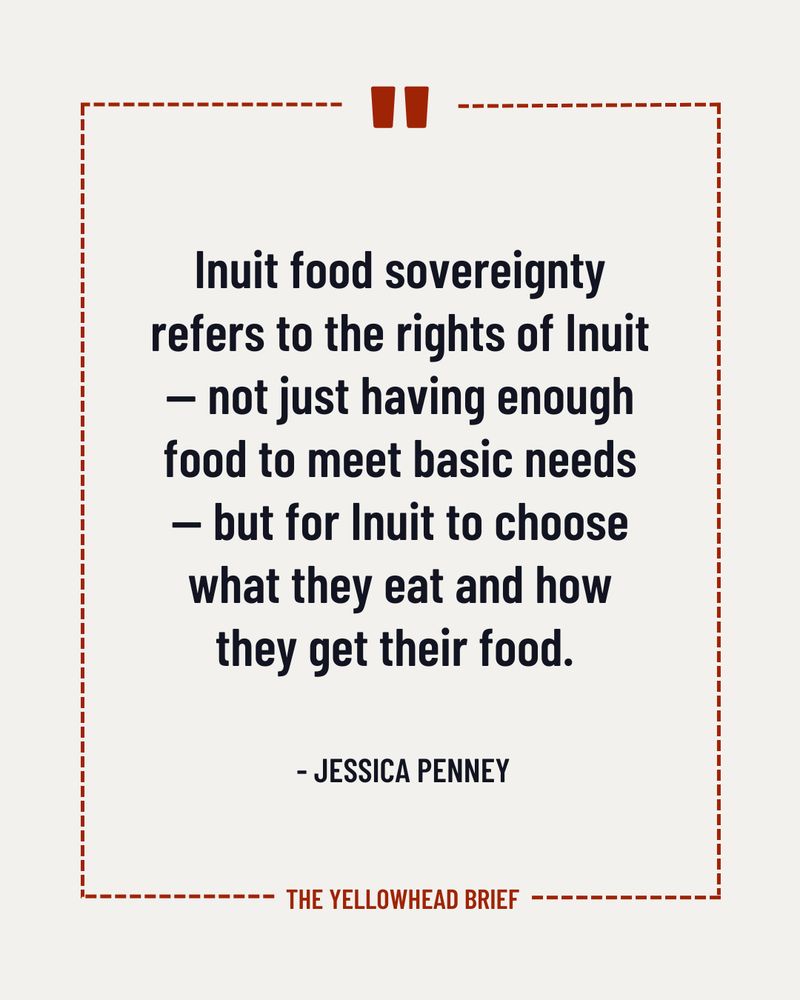
a quote is bordered by a dashed red line. A quotation mark sits at the top centre of the border and “The Yellowhead Brief” is placed in the bottom centre of the border. Inside the border reads: Inuit food sovereignty refers to the rights of Inuit — not just having enough food to meet basic needs — but for Inuit to choose what they eat and how they get their food.

Image is of a dark blue background. A dark red text box is displayed in the top centre of the image, white text reads, “Learn More”. White text in the centre of the image reads: What if policy approaches to Arctic sovereignty focused on building healthy communities rather than on militarization and extractivism? Below this, smaller white text reads the title information:, BRINGING INUIT FOOD SECURITY AND SOVEREIGNTY INTO CANADIAN NATION-BUILDING NARRATIVES BY JESSICA PENNEY
. A dotted red line separates the title information from the Yellowhead Institute logo displayed in the bottom centre of the image.
Canada has renewed its focus on Arctic sovereignty. Jessica Penney argues that Arctic security cannot exist while Inuit communities face unmet basic needs. With food insecurity still alarmingly high, Arctic sovereignty must centre Inuit self-determination.
Read the full Brief on our website.
02.09.2025 15:50 — 👍 1 🔁 0 💬 0 📌 0

Several Haudenosaunee wampum belts hang outdoors on a wooden pole, above text promoting a Public Administration and Indigenous Governance Program at Toronto Metropolitan University.
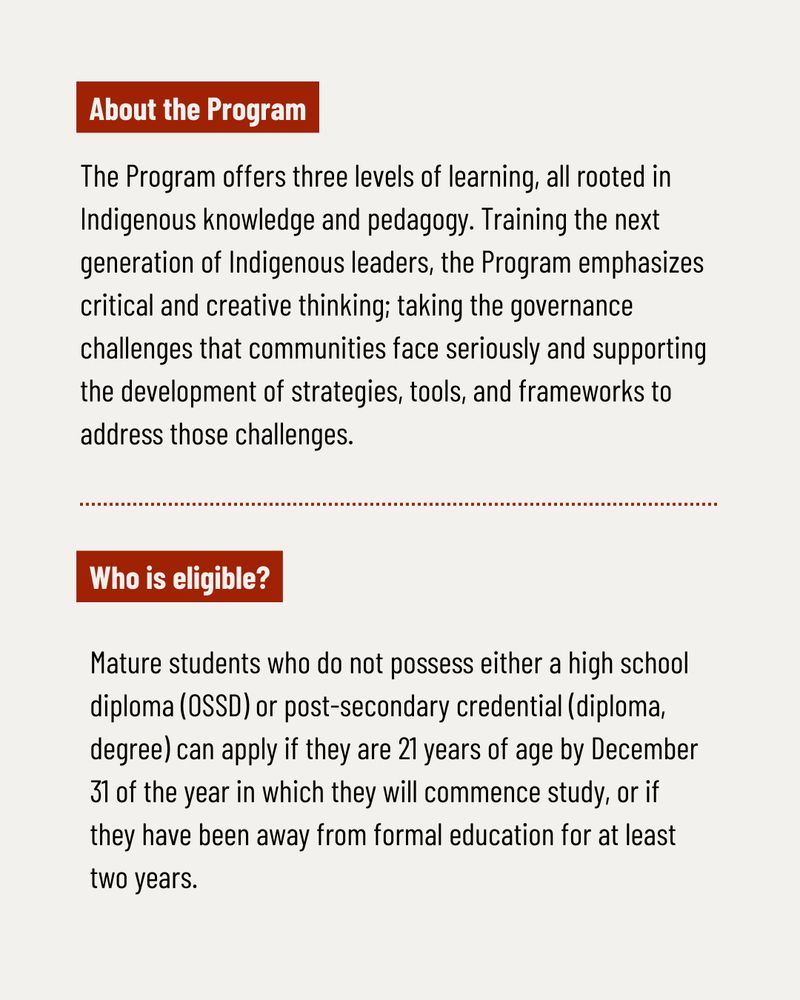
A text-based image describing a program for Indigenous students, including eligibility for high school graduates or post-secondary credential holders who’ve been away from formal education for at least two years.

An infographic about an academic program for Indigenous students from remote communities, highlighting intensive format, hybrid learning, Indigenous-led courses, and student support services. The background is red and white with bold headings.

Announcement for Public Administration and Indigenous Governance Program: "Applications are open for the fall semester!" Includes program link (yellowheadinstitute.org/paig-program), contact info for FNTI (.800.267.0637 ext. 141 or recruitment@fnti.net.) and Yellowhead Institute, and logos of FNTI, Yellowhead Institute (linda.bui@torontomu.ca), and TMU.
We’re thrilled to announce the renewed Public Administration and Indigenous Governance (PAIG) Program, run in partnership with FNTI based at Tyendinaga Mohawk Territory and the Dept. of Politics at TMU. Visit yellowheadinstitute.org/paig-program for more details and how to apply 📚
20.08.2025 14:27 — 👍 1 🔁 0 💬 0 📌 0
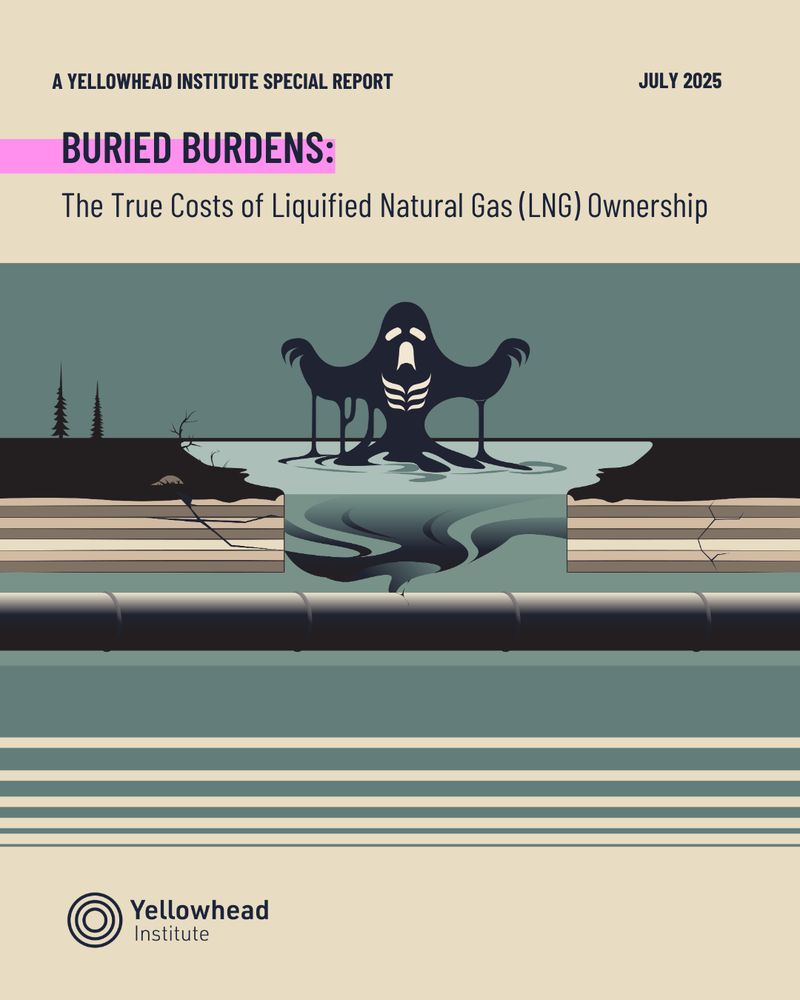
At the top of the slide reads the report title in black front: “Buried Burdens: The True Costs of Liquified Natural Gas (LNG) Ownership” Below it is artwork by Brett Huson, depicting an oiled being standing over a pipeline. The yellowhead institute logo sits in the bottom left corner.

Below a centred black quotation mark icon, the slide reads: “No matter your understanding of economics, we must understand that our obsession with unrestricted growth is killing the very thing that sustains us. Our relationship with and actions upon the environment are interconnected: We cannot exist without a healthy environment and the tools to steward it according to Indigenous laws.” The special report information lines the bottom of the slide in a green bar: “From the Yellowhead Special Report, Buried Burdens: The True Costs of Liquified Natural Gas (LNG) Ownership
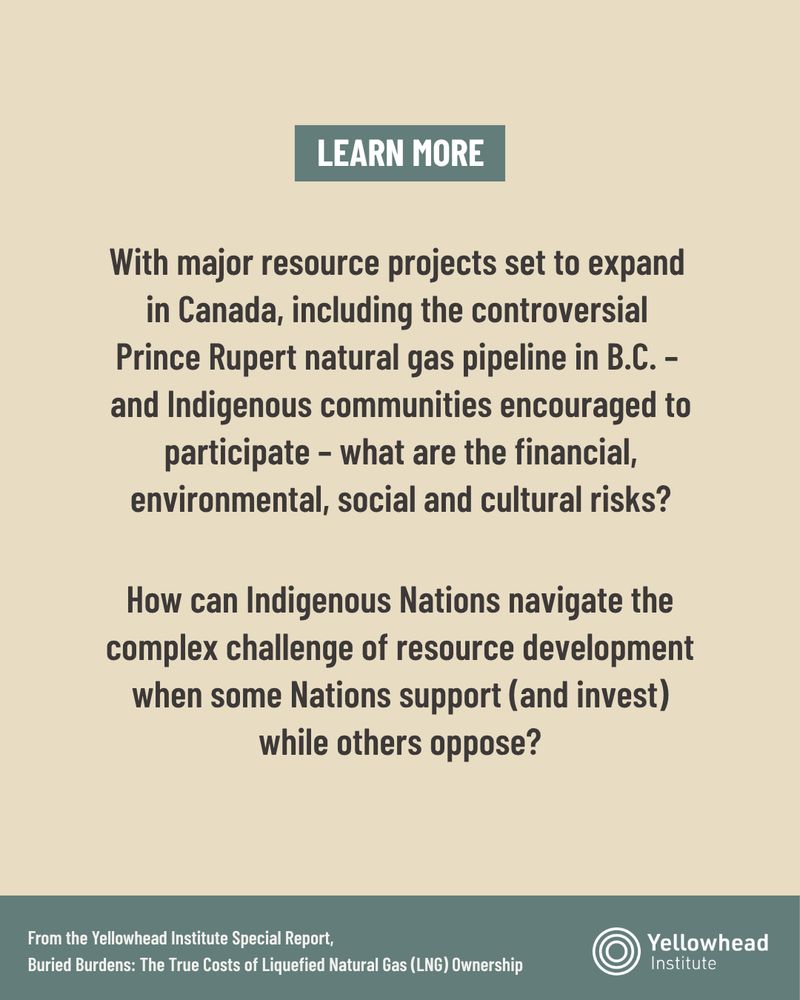
Title text reads: “LEARN MORE.” Below it, body text reads: “With major resource projects set to expand in Canada, including the controversial Prince Rupert natural gas pipeline in B.C. – and Indigenous communities encouraged to participate – what are the financial, environmental, social and cultural risks?” And “How can Indigenous Nations navigate the complex challenge of resource development when some Nations support (and invest) while others oppose?” The special report information lines the bottom of the slide in a green bar: “From the Yellowhead Special Report, Buried Burdens: The True Costs of Liquified Natural Gas (LNG) Ownership

Pictured is a photograph by Mike Graeme of the Skeena River
As governments pass legislation to fast track resource development, a long-delayed LNG pipeline in B.C. has been approved. Buried Burdens considers PRGT's history, identifying a number of issues.
Read the full Special Report on our website: yellowheadinstitute.org/buried-burde...
22.07.2025 16:44 — 👍 13 🔁 15 💬 0 📌 3

Top half of the image displays a photograph of a Sunrise at Skidegate. A red line across the image beneath the photo. Within the line reads: “The Yellowhead Brief”. The bottom half of the image displays the brief title information: July 15, 2025, Recognition and Erasure of Indigenous Oceanic Rights and Title by Michaela M. McGuire - Jaad Gudgihljiwah and Rosanna Carver. The YI logo is displayed on the right side of the image.

Top half of the image displays a photograph of a Sunrise at Skidegate. A red line across the image beneath the photo. Within the line reads: “The Yellowhead Brief”. The bottom half of the image displays the brief title information: July 15, 2025, Recognition and Erasure of Indigenous Oceanic Rights and Title by Michaela M. McGuire - Jaad Gudgihljiwah and Rosanna Carver. The YI logo is displayed on the right side of the image.

Image is of a dark blue background. A dark red text box is displayed in the top centre of the image, white text reads, “Learn More”. White text in the centre of the image reads: How do resource development infrastructure projects in the ocean, like Ksi Lisims – a floating LNG processing facility – bypass Indigenous Rights and Title? Below this, smaller white text reads the title information: Recognition and Erasure of Indigenous Oceanic Rights and Title by Michaela M. McGuire - Jaad Gudgihljiwah AND ROSANNA CARVER. A dotted red line separates the title information from the Yellowhead Institute logo displayed in the bottom centre of the image.
In this Brief, Michaela McGuire and Rosanna Carver discuss the impacts of resource development infrastructure in the ocean and the Crown's limited interpretation of Indigenous oceanic rights and title.
Read the full Brief on our website: yellowheadinstitute.org/the-yellowhe...
15.07.2025 18:02 — 👍 0 🔁 0 💬 0 📌 0

Top half of the image displays a photograph of a group of people working in fields. A red line across the image beneath the photo. Within the line reads: “The Yellowhead Brief”. The bottom half of the image displays the brief title information: Hidden Hunger in Indonesia: Indigenous Food Insecurity by Nikodemus Niko. The YI logo is displayed on the right side of the image.

a quote is bordered by a dashed red line. A quotation mark sits at the top centre of the border and “The Yellowhead Brief” is placed in the bottom centre of the border. Inside the border reads: A humanitarian crisis is currently unfolding and is likely to persist into the foreseeable future. The tragic accounts of children and the elderly losing their lives to hunger in the remote regions of Papua Province serve as a stark reminder of the deep failures in the food system.

Image is of a dark blue background. A dark red text box is displayed in the top centre of the image, white text reads, “Learn More”. White text in the centre of the image reads: As Indonesia further develops an agricultural sector, traditional food systems are being compromised. What are the consequences for Indigenous communities? Below this, smaller white text reads the title information: Hidden Hunger in Indonesia:Indigenous Food Insecurity by Nikodemus Niko. A dotted red line separates the title information from the Yellowhead Institute logo displayed in the bottom centre of the image.
Indonesian governments have neglected the protection of Indigenous rights, resulting in the theft and destruction of Indigenous lands and food. Nikodemus Niko describes "hidden hunger" and calls the Indonesian government to implement reforms to protect Indigenous rights.
Full Brief on our website
18.06.2025 15:31 — 👍 0 🔁 0 💬 0 📌 0

Top half of the image displays a photograph of a banner that reads kill bill 5. A red line across the image beneath the photo. Within the line reads: “The Yellowhead Brief”. The bottom half of the image displays the brief title information: JUNE 05, 2025 | #166, The Elbows Are Up: Ontario’s “Special Economic Zones” and Indigenous Rights by Hyden King.
The YI logo is displayed on the right side of the image.

a quote is bordered by a dashed red line. A quotation mark sits at the top centre of the border and “The Yellowhead Brief” is placed in the bottom centre of the border. Inside the border reads: The economic crumbs of resource extraction projects on offer are not incentives. They are insulting, considering those resources belong to First Nations.

Image is of a dark blue background. A dark red text box is displayed in the top centre of the image, white text reads, “Learn More”. White text in the centre of the image reads: First Nations in Ontario are nearly universally opposed to Ontario’s contentious "Protect Ontario by Unleashing the Economy" legislation. Does the law reflect a new approach to Indigenous rights in the province and Canada more broadly? Below this, smaller white text reads the title information: The Elbows Are Up: Ontario’s “Special Economic Zones” and Indigenous Rights by Hayden King. A dotted red line separates the title information from the Yellowhead Institute logo displayed in the bottom centre of the image.
Despite First Nations protests, Ontario passed omnibus legislation creating "Special Economic Zones," gutting key environmental and consultation laws. Hayden King warns this trend sidelines Indigenous rights and may spark renewed land and legal conflict.
Full Brief on our website, linked in bio.
05.06.2025 17:00 — 👍 8 🔁 6 💬 0 📌 0

Top half of the image displays a photograph of hummingbird artwork by cherylanne james. A red line across the image beneath the photo. Within the line reads: “The Yellowhead Brief”. The bottom half of the image displays the brief title information: The Indigenous Justice Strategy: “Progressive and Transformative Reform”? By Kanatase Horn. The YI logo is displayed on the right side of the image.

a quote is bordered by a dashed red line. A quotation mark sits at the top centre of the border and “The Yellowhead Brief” is placed in the bottom centre of the border. Inside the border reads: The Indigenous Justice Strategy (IJS) can be described as a vision for necessary change – reducing Indigenous over-representation while also supporting Indigenous self-determination. More than anything, the IJS is best understood as a framework or pathway to achieve this sort of change.
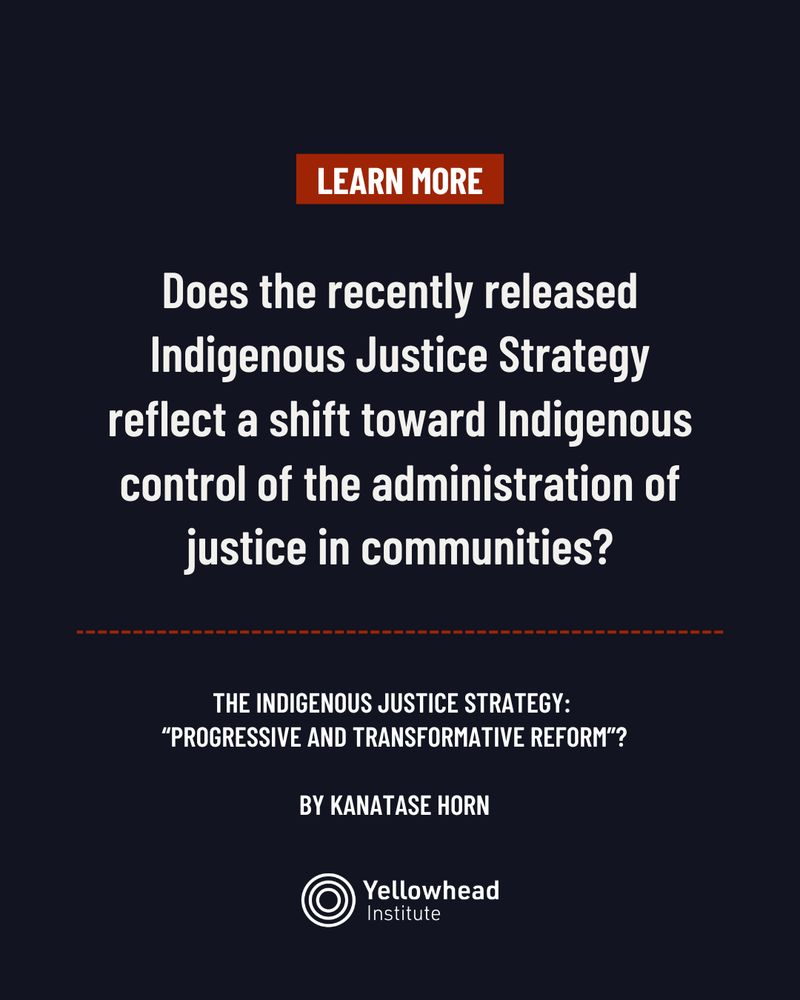
Image is of a dark blue background. A dark red text box is displayed in the top centre of the image, white text reads, “Learn More”. White text in the centre of the image reads:Does the recently released Indigenous Justice Strategy reflect a shift toward Indigenous control of the administration of justice in communities? Below this, smaller white text reads the title information: The Indigenous Justice Strategy: “Progressive and Transformative Reform”? By Kanatase Horn. A dotted red line separates the title information from the Yellowhead Institute logo displayed in the bottom centre of the image.
Canada and Indigenous communities collaborated on a new Indigenous Justice Strategy framework to reduce Indigenous over-representation in the criminal justice system. As mass criminalization of Indigenous people is widely recognized as a national crisis, can the IJS offer change?
Linked in bio.
21.05.2025 14:57 — 👍 2 🔁 0 💬 0 📌 0

Heading text reads: “Help us understand how you're using our research and resources!" Smaller text reads: "Fill out a 5 min survey for a chance to win a Yellowhead gift bag!”
Image shows a tote bag, camo baseball hat, two Red Paper reports, stickers, and a matchbook.
Interested in receiving Yellowhead swag? Fill out a five-minute survey to help us understand how you're using our research & resources, and be entered in a draw to win a Yellowhead gift bag! Access the survey here: forms.gle/d15WGeN1vvM9...
01.05.2025 15:16 — 👍 3 🔁 1 💬 0 📌 0

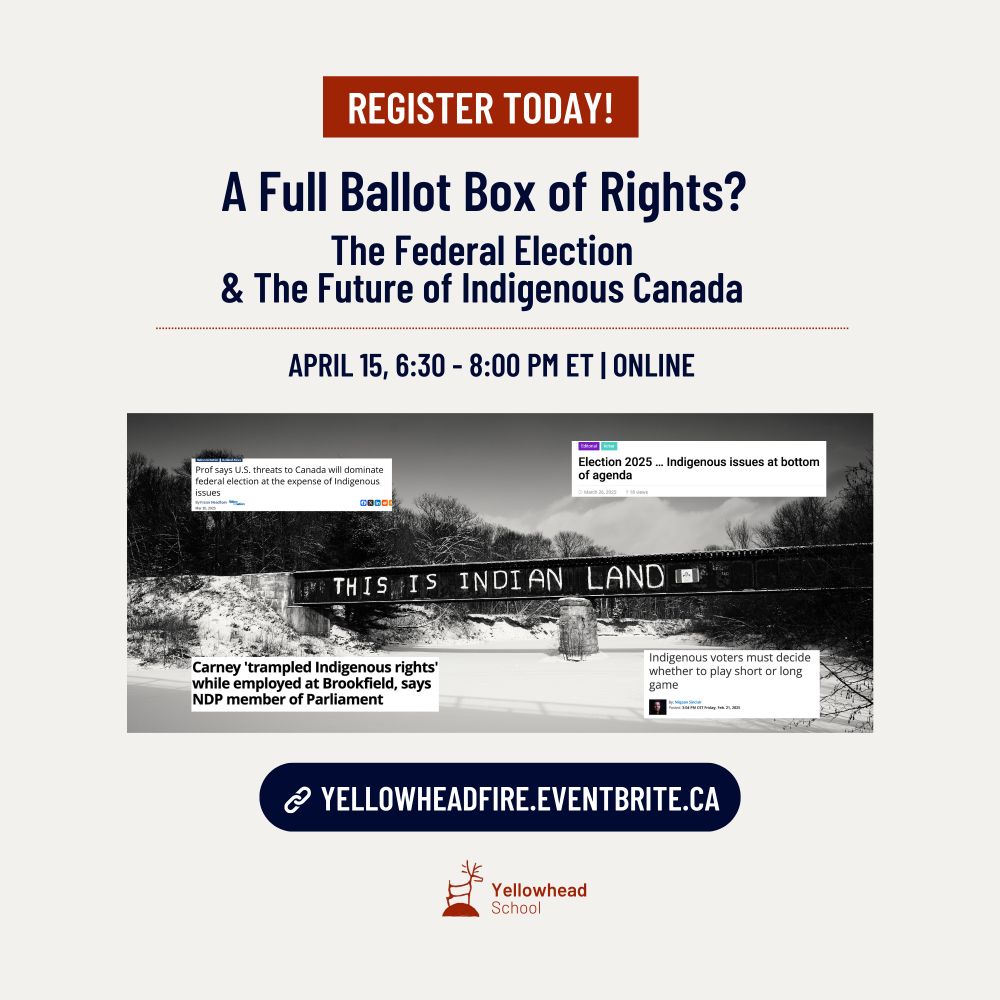
Join us on April 15th for a Yellowhead fire the upcoming federal election. As we approach a new federal leadership, what could the future look like for Indigenous-Canada? Register: yellowheadfire.eventbrite.ca
08.04.2025 19:13 — 👍 5 🔁 3 💬 0 📌 1


We’re searching for an Indigenous artist to design and execute the installation of a mural at our first space! More details at yellowheadinstitute.org/work-with-us
02.04.2025 20:42 — 👍 2 🔁 0 💬 0 📌 0

Centre left text reads, “Sara Mai Chitty is Michi Sagig Anishinaabekwe, otter clan and a member of Alderville First Nation. Sara Mai has her master's in journalism and currently works in post-secondary education sharing wise practices in Indigenous curriculum and pedagogy. She wears many hats including climate change activism, podcasting, and freelancing.” Centre right is a polaroid of and text with the name Sara Mai Chitty.
Top right text reads, “As an alumnus of the first iteration of the Radical Policy School (now MAKE), she deeply values the experience, and the relationships she formed with other participants, and is excited to be engaged with MAKE in another capacity.” Top left is a polaroid and candid photo of Sara Mai smiling and holding up Tatreetz, traditional Palestinian embroidery. She is swearing a radical policy school designed crewneck. Text under reads “Image: Sara Mai During RPS 2024”
In the background are dotted wavy lines. Bottom banner is a logo with a caribou and text reading “Misko Aki Knowledge Exchange”. In bottom right corner, text reads “A Yellowhead School Program”

Title reads “Apply Today”. Main text reads “Applications are open until February 24, 2025. More details and how to apply at yellowheadinstitute.org/2025-misko-aki-knowledge-exchange”
Centre image is a logo with a caribou and text “Misko Aki Knowledge Exchange” and “A Yellowhead School Program”.
✨It’s not too late to apply — MAKE applications close this Monday, February 24. Learn more and access the application form, linked in bio. ✨
3/3
19.02.2025 18:27 — 👍 0 🔁 0 💬 0 📌 0

Centre left text reads “Ja'miil (she/her) completed the 2024 Radical Policy School (now Misko Aki Knowledge Exchange) with Yellowhead, drawn to the program’s focus on social transformation through themes like relationality, solidarity, navigating conflict, and abolition”. Centre right is a polaroid photo of and text with the name Ja’miil.
Top right text reads “Born in so-called Canada of Bajan-Palestinian descent, her social location shapes the spaces she engages in and influences her expression through writing, facilitation, and community work.” Top left is a polaroid and candid photo of Ja’miil in conversation with other participants; she is wearing a Palestinian keffiyeh. Text under reads “Image: Ja’miil During RPS 2024”
In the background are dotted wavy lines. Bottom banner is a logo with a caribou and text reading “Misko Aki Knowledge Exchange”. In bottom right corner, text reads “A Yellowhead School Program”
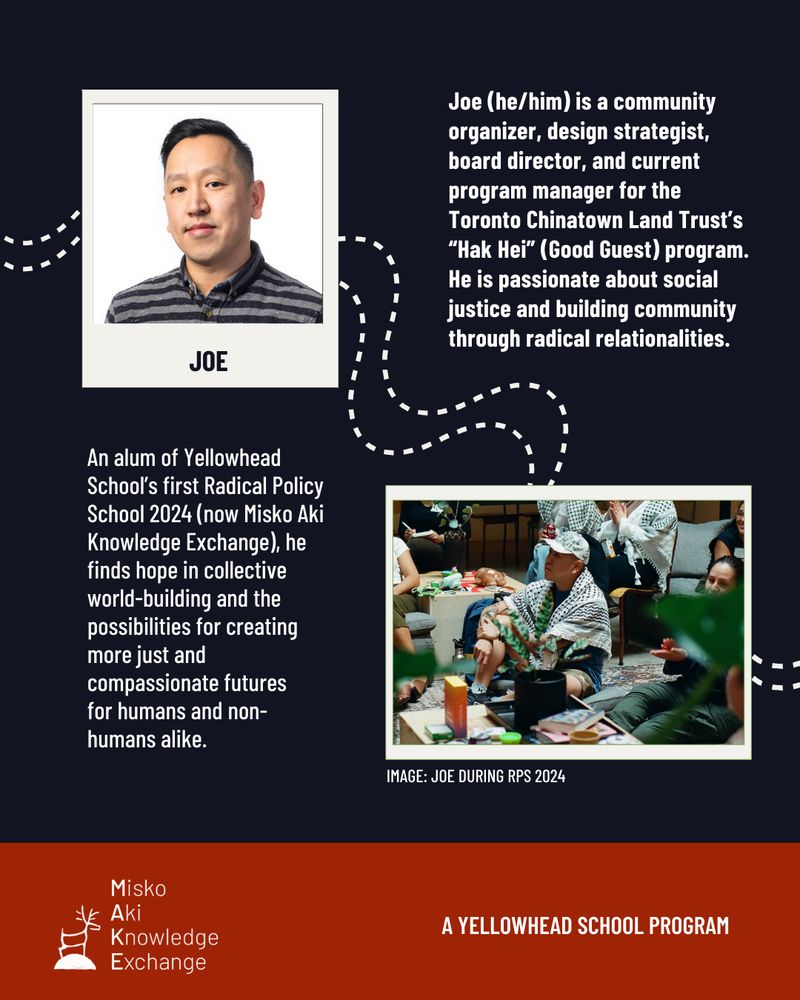
Top right text reads, “Joe (he/him) is a community organizer, design strategist, board director, and current program manager for the Toronto Chinatown Land Trust’s “Hak Hei” (Good Guest) program. He is passionate about social justice and building community through radical relationalities.” Top left is a polaroid photo of and text with the name Joe.
Centre left text reads “An alum of Yellowhead School’s first Radical Policy School 2024 (now Misko Aki Knowledge Exchange), he finds hope in collective world-building and the possibilities for creating more just and compassionate futures for humans and non-humans alike.” Centre right is a polaroid and candid photo of Joe sitting on the floor with participants in the background; he is wearing a Palestinian keffiyeh. Text under reads “Image: Joe During RPS 2024”
In the background are dotted wavy lines. Bottom banner is a logo with a caribou and text reading “Misko Aki Knowledge Exchange”. In bottom right corner, text reads “A Yellowhead School Program”
Composed of some alumni from 2024 MAKE (previously Radical Policy School), the committee will bring their experiences and expertise in community and solidarity building to the review process.
2/3
19.02.2025 18:27 — 👍 0 🔁 0 💬 1 📌 0

Title reads “Meet the MAKE 2025 Selections Committee”. In the centre, four images of polaroid photos of smiling faces. Each includes the name of the person that is featured in the photo (from left to right, top to bottom: Lindsay Debassige, Ja’miil, Joe, and Sara Mai Chitty.” Main text reads “The committee is composed of alumni from our 2024 MAKE (prev Radical Policy School) program.”
In the background are dotted wavy lines. In the bottom banner is a logo with a caribou and text reading “Misko Aki Knowledge Exchange”. In bottom right corner, text reads “A Yellowhead School Program”

Top right text reads “Lindsay Debassige is a Two-Spirit M'Chigeeng Anishinabek born and raised in Sǫ̀mba K'è , Denendeh. They are the current Executive Director for Qmunity Camp NWT, providing on the Land opportunities to Two Spirit, Indigiqueer, Queer and Transgender Indigenous Youth in the North.” Top left is a polaroid photo of and text with the name Lindsay Debassige.
Center left text reads “Lindsay loves spending time out on the Land, engaging in traditional arts, watching scary movies, and cuddling her fur babies. They are passionate about building ethical, anti-racist, decolonial spaces and empowering First Nations, Inuit and Metis peoples of Denendeh to reclaim their culture, traditions, language, and identity. #LANDBACK”. Center right is a polaroid and candid photo of Lindsay sitting on the floor with participants in the background. Text under reads “Image: Lindsay During RPS 2024”
In the background are dotted wavy lines. Bottom banner is a logo with a caribou and text reading “Misko Aki Knowledge Exchange”. In bottom right corner, text reads “A Yellowhead School Program”
We’re thrilled to announce the selections committee for this year’s Misko Aki Knowledge Exchange (MAKE). Say hello to Lindsay, Ja’miil, Joe & Sara Mai! 👋🏿👋🏾👋🏽
1/3
19.02.2025 18:27 — 👍 3 🔁 0 💬 1 📌 0


























